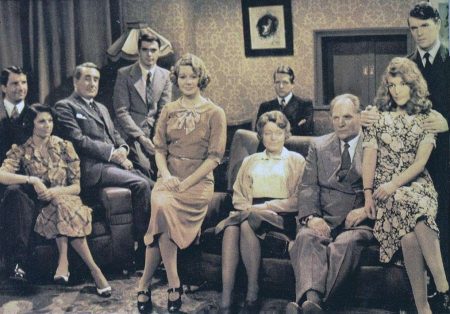ITV recently broadcast Goodbye Granadaland, a 90 minute valedictory celebration of the output of Granada’s studios in central Manchester ahead of its forthcoming relocation to the nearby Salford Media City complex. The programme lined up a nostalgic parade of programmes from Granada’s programming history: the television milestone Coronation Street –obviously – as well as pioneering factual series running the gamut from World in Action to This Morning. However, among the impressive line-up of prestige drama production that was cited in the programme, including Brideshead Revisited, The Jewel in the Crown and Prime Suspect, no mention at all was made of one of Granada’s biggest hits of its formative years: the epic series A Family at War (1970 to 1972).

A Family At War. Source: https://bearalley.blogspot.de/2010/09/tv-tie-ins-family-at-war.html
It looks as though this programme may be in danger of dropping off the popular radar, not to mention the academic radar; for instance, it isn’t included in Lez Cooke’s excellent overview British Television Drama, even as a footnote. And yet when A Family at War was first shown in the early 1970s it was a quite remarkable success. According to one contemporaneous report, the programme’s ‘opening episode was seen in 6,850,000 homes, probably representing some 20 million viewers’, taking it ‘straight into the top ten with its first programme’, only just below the well-established Coronation Street in the ratings (Sun, 28 April 1970). By August that same year, one of Granada’s press releases was able to boast that A Family at War was now ‘top of the national TV ratings.’ Interesting to note too that this was a series which enjoyed spectacular popularity overseas, especially in Scandinavia where it became one of the top-rated programmes of all time – an interesting reversal of the current British media enthusiasm for all things Nordic.
Such a mismatch between the drama’s immense popularity with viewers at the time and its present critical obscurity points towards A Family at War being another instance, albeit a historical one, of what Brett Mills has described as the phenomenon of ‘invisible television’, the shows that lots of people watch but academics don’t write, let alone enthuse, about. But more than the existence of any blockbusting historical viewing figures, my motivation for writing about A Family at War undoubtedly comes from my personal enthusiasm for the series, interlinked with a considerable investment of time spent viewing its 52 hour-long episodes over a lengthy period: I lived alongside this series and its characters for the best part of a year – including during pregnancy, making me wonder if the programme’s highly distinctive and melancholy theme music (by Vaughan Williams) may also have filtered into my unborn daughter’s consciousness as I sat with my feet up, mug of tea in hand, telly on. Although sometimes working through such a marathon viewing task felt like a feat of endurance as much as a pleasure, on balance I think it was precisely because of the epic duration and stately pace of the series that I became so thoroughly enamoured with it.
Sandcastle under siege: the stately sombre opening and closing sequences of A Family at War
Being able to watch the whole of A Family at War had only been made possible because of its release on DVD box-set by Acorn Media UK, bringing another previously unobtainable television text back into the public domain. My mode of viewing the programme swung between the ‘bingeing’ often seen as characteristic of contemporary TV-on-DVD viewing practices, with several episodes watched in one sitting, and an alternative way of consuming the series that came closer to replicating its original weekly pacing, engendering a far slower rate of progression which actually seemed more appropriate for its subject matter, the duration of the Second World War from the fears of 1938 right through to V.E. Day.
The series follows the lives of the various members of a single family, the Ashtons, of approximately lower-middle-class status (although their class position is actually more complex and piebald than this label might suggest), mostly based in their Liverpool home but with narrative excursions to other locations as various family members were drafted into the armed forces, mobilised or evacuated. The original title for the series envisaged by its creator and main writer John Finch was ‘Conflict’, its dual meaning retained when it was subsequently re-titled as ‘A Family at War’. The war it refers to is both external force, the global struggle that defines the historical moment the Ashtons inhabit, and an internal schism, their own private combat zone which is affected by but by no means entirely due to the exigencies of that larger conflict.
Class conflict is absolutely pivotal to the Ashtons’ story. The apparently happy cross-class marriage of parents Edwin (Colin Douglas), from mining stock, and Jean (Shelagh Fraser), decidedly middle class in background, comes under increasing strain as the years progress and various tragedies impact upon the family. A continual bone of contention is Edwin’s poor treatment at the hands of his brother-in-law and employer Sefton Briggs (a terrifically villainous performance by John McElvey) while further stories of class struggle stem from the different wartime destinies of two of Edwin and Jean’s sons, leftist Oxford graduate Philip (Keith Drinkel) and initially unemployed Angry Young Man David (Morrissey favourite, Colin Campbell). But as its title suggests, A Family at War pays equal attention to private and domestic politics as it does to the public political sphere and its female characters are at least as complex and intriguing as its men, from the matriarchal Jean, to her eldest daughter Margaret (Leslie Nunnerley) who endures a fraught relationship with her jealous mother-in-law Celia Porter (Margery Mason), to David’s long-suffering wife Sheila (Coral Atkins), through to the skittish youngest Ashton daughter Freda (Barbara Flynn). Critics at the time sometimes complained of ‘women’s magazine atmospherics’ (Daily Mail, 21 January 1971), or that the show’s appeal replicated that of ‘the women’s magazines my mother used to read’ (Daily Express, 12 November 1970) or even that its narrative catalysts were nothing more than ‘the puny domestic bombshells that trigger off all soap opera, in fact.’ (Daily Sketch 12 November 1970). However, putting aside the critical bias against media aimed at women evident in such remarks, my impression on watching A Family at War nearly forty years on was of a programme which managed very successfully to interweave the personal and the public and to suggest their inextricable interconnections, invoking both the broad canvas of unparalleled world war and political upheaval and what it meant to live through it for one particular Liverpool family.
A brief scene between brother and sister Robert (David Dixon) and Freda (Barbara Flynn), the youngest Ashton siblings.
Nor does the programme pull its punches: several central characters die during the course of the series and those left behind have to struggle on imperfectly, while the skilful writing makes plain the emotional damage they suffer as they do so. A Family at War never smacks of the plucky ‘keep calm and carry on’ rhetoric typical of more nostalgic visions of wartime, and repudiates any patriotic pleasures in favour of a much more sombre and downbeat vision. Its aesthetic was frugal, quickly-produced studio-bound drama in the main with some location shooting when necessary, but again that seemed to work with the grain of the show rather than against it. The series was often criticised for its gloominess – as one critic wrote satirically of its title sequence, ‘Cue in groaning music. Fade up picture of bleak fortress… time to meet that loveable, laugh-a-minute Liverpool gang, the Ashtons.’ (Sun, 7 October 1971) – but that seems a little unfair. As the series creator John Finch later observed: ‘I have often had to try to shrug off descriptions of my work as “dour” or “glum” – inevitable I suppose since most of my writing has been about poverty or war.’ And in any case, the intrigues and affairs, the stand-up rows and the unspoken tensions are all sufficiently fascinating to make A Family at War a deeply compelling drama. Viewers certainly thought so at the time of its original transmission, keeping at the top of the ratings throughout its long run. One writer even observed that its viewing figures were ‘sufficiently impressive to encourage a “Coronation Street” infinity’ (Daily Telegraph, 5 August 1970) while another ‘bet a year’s supply of the TV Times that it will roll merrily on into student-riot times. Already in Granadaland they are talking about the show going on to encompass the fifties. Certainly I was not the first to suggest the title A Family at Peace.’ (Sunday Mirror, 2 August 1970). All of which commentary prompts an intriguing ‘what if?’ of British television history: ‘What if A Family at War had continued and become a long-running series like Coronation Street?’
But this never happened – although John Finch did write a kind of sequel in the shape of The Spoils of War (1980-81) – and instead this hugely popular programme of the early 1970s occupies a strangely subdued position in television historiography, ‘missing in action’, especially when compared to a television landmark such as The World at War (1973-74), Thames Television’s definitive historical documentary series which came just afterwards but which has been much more widely (and justifiably) celebrated. And yet despite their obvious differences in genre and approach, the two series inadvertently have a lot in common, both being epic in length and driven by a desire to provide as comprehensive a chronicle of the war as possible but one achieving that end through microcosm and the other by macrocosm. And both, it is worth reiterating, were products of British commercial television, testimony to its ability to combine high seriousness and immense popularity. As a totally engrossing television chronicle of the Second World War through the fortunes of a single divided family, Granada’s A Family at War deserves to take its rightful place as a seminal piece of British television drama: a series ‘capable of magnificence’ (Sunday Telegraph, 21 March 1971).
Melanie Williams is Reader in Film and Television Studies at the University of East Anglia. She is the author of David Lean (2014) and Female Stars of British Cinema (2017) and a co-investigator on the AHRC-funded project ‘Transformation and Tradition in 1960s British Cinema’.





I so enjoyed reading Melanie Williams article about A Family At War. I discovered this series via the dvds released by Acorn Media UK. I found it to be a well acted series that really brought home the harsh realities that those living through the times endured. I too have found very little mention of this excellent drama series whenever classic British Television is discussed. Thank you Melanie for bringing this series back into prominence.
I watched Family at War as a child with my parents and always wanted to be able to see it again . Thanks to Talking Pictures, which has broadcast all the episodes this year, I have had this chance and it had all been every bit as good as I remembered it to be and more so!
It is good to see that eventually it is becoming recognised for the quality of its production. FAW iprovides an excellent insight into civilian experiences during this period of time in our history, the acting is excellent and the story lines thought provoking and compelling.
A good way fo younger generations to be educated in the way life was for ordinary people during those difficult years.
I was born in 1970. Blown away and in love with this series, so glad Talking Pictures have rekindled it. Please show it again, I only caught some of the third series.
This is a great review and comment of the series. My husband and I were stationed at Lakenheath when this series premiered and I scheduled my viewing time accordingly.
Additionally I believed I was able to achieve a better understanding of what life was really like during the war, rationing, air raids, time spent in shelters, agony of traveling by train and the overall mood of the country. My mother was from London and told us about her experiences however I really didn’t fully understand the impact on the home life until I watched the series. It was the most realistic depiction of wartime home life I have seen to date.
I was so excited when the series came out on DVD that I ordered an “all regions” DVD player so that I could order it. I live in the US and our region is different so under ordinary circumstances DVDs produced in England were unplayable in the US.
Another interesting aside to my viewing the series was the concurrent coal miners’ strike at the time. If our power outage was during the broadcast time you were out of luck. Many people complained to the Radio Times and I believe Granada may have rerun some episodes.
I also know there was a considerable amount of nit picking regarding accuracy of items on the set, for example packets in the kitchen, month of Frank Sinatra song played on the radio while the family waits for Churchill speeches, etc. I found this nit picking intriguing and amusing as I wondered if the audience that complained paid any attention to the over arching story lines. However, remembering that a large majority of the viewers had actually experienced the circumstances as lived by the TV family, I respected their level of interest in accuracy.
Regardless it was absolutely amazing and I was impressed by the whole production and whenever I hear that particular Vaughn Williams piece on the radio I instantly am reminded of the series, as I am when they play the Boccherini piece that was in the Peter Sellers’ film, The Lavender Hill Mob.
Thanks for the article and the series. I don’t believe see any like this in the future.
An excellent piece on a sadly neglected classic of British television.
It might be worth adding that the vast majority of the original audience will probably have first watched it in black and white. Although it was broadcast in colour (for the most part) and colour sets had been available since the late 1960s, at this time they were still very much a luxury item and didn’t really penetrate the mass market until much later. My own, family fairly typical of a working class family of the era, didn’t get a colour set until 1975. People generally waited until their old set gave up the ghost before switching, and in those days sets could last a long time.
Growing up in the 60s, like most of my generation I had been reared on Britain’s obsession with World War II. We read war comics, watched war films, and made models of the most famous aeroplanes from the Battle of Britain, like the Spitfire and Hurricane. I remember sitting down to watch AFaW with my mother, expecting somethjng along the lines of a war film or something similar to the Colditz series about prisoners of war from the same period. What I saw of course was something entirely different, not only in that it largely covered the home front rather than the battles themselves, but also because it involved a middle class family, and demonstrated to me just how the war differed for the classes in Britain, as I’d long heard stories of the war from my parents and the deprivation they faced as a working class family in a poor area. The Ashtons seemed relatively prosperous despite war and the rationing.
Nevertheless, although I was was far from its target audience, I still found the series compelling. Yes, much of the domestic intrigue probably passed me by, but other issues hit home strongly – the various brothers away at war while life continued at home, the character of Sefton Briggs (played by John McKelvey), who struck me as being particularly sinister, and the lovely Sheila Ashton (played by Coral Atkins) who struck a young boy in a rather different way. Mostly though, it was the presence of the war which made itself felt throughout, despite rarely being depicted directly. As the Ashton family sat down in their living room in the evening, behind the blackout curtains you could sense the presence of a city and country at war. People came in from the darkness with the war about them, as though coming in wet from a storm. The war was the unseen contributor to every scene, and informed the central theme of the series – that day to day life continues even in extreme circumstances.
This was all of a very high calibre: the writing, the filming, the acting, the whole programme. I’ve since seen it referred to as a soap opera. I think this is grossly unfair, and it’s not a description that was applied to it at the time as far as I remember. It was regarded as having much more in common with the high quality plays and dramas being produced by the BBC at the time, and seemed to be ITV’s response. It had little in common with the soap operas of the 70s, which were cheaply produced and lacked AFoW’s attention to detail and quality of writing and production.
Looking back, the quality of television output by both BBC and ITV at that time is staggering, a golden era indeed.
Edit-
“My own family, fairly typical of a working class family of the era, didn’t get a colour set until 1975.